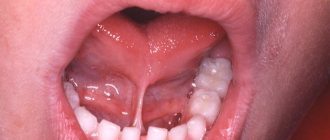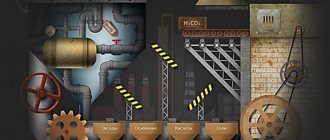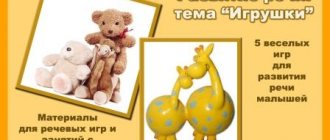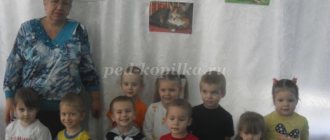Games and exercises to consolidate sound pronunciation and develop phonemic awareness
Games and exercises
on consolidation
sound pronunciation and development
phonemic representations
1
Exercise “What sound is in the word? "
Target:
To develop phonemic hearing, speech attention of children, to consolidate the pronunciation of the sounds S, S in words.
Material.
A picture whose title contains the sound
s
or
s
'; flannelograph; blue and green circles.
Progress:
Educator. We sang songs of the big and small pumps. Their songs are similar to the sounds in words: with
- big brother, s' - little brother.
Children are given pictures (an approximate list of them: bag, leaf, snowman, airplane, tit, cabbage, sleigh, cornflower, lilac, pig, goose, little fox, bicycle, month...).
Educator. The names of our items contain sounds with
or with'.
Listen to how I name the objects: “ Sssdog
is the sound
with
, “
sssinichka
” is the sound
with
'.
- Now you will name your objects and say what sound is in this word.
Children take turns going to the board, name the object, determine the presence of a particular sound and put the picture on the flannelgraph after the blue one (sound with
) or after green (sound
with
) circle.
Then one child names all the words with the sound s, the other - with the sound s
‘.
2 Game "Birds"
Target:
Develop speech attention, phonemic hearing, consolidate the pronunciation of the sounds I, Yu.
Material.
For each child and teacher, one yellow or red square (the teacher has both squares); flannelgraph and pictures depicting a chicken, kitten, kid, dog, bush, hen.
Progress:
Teacher (distributing yellow squares to one half of the group and red squares to the other).
You are birds. Those who have a red square will sing: “Yu-yu-yu-yu-yuuuu”, those who have a yellow one will sing: “Ya-ya-ya-yaaaa.” See which square I will lift and sing songs of different birds.
The teacher raises the squares in random order, and the children sing the corresponding songs (3 times). Then the children change roles and the game is repeated.
3
Game “Bells”
Purpose:
To develop children's speech attention and phonemic hearing, to consolidate the pronunciation of the sounds Z, ZZ in words.
Material.
Large and small mugs of any color; flannelgraph and blue and green mugs; pictures depicting a hare, a basket, a fence, strawberries, a goat, a rose, a mirror, an umbrella.
Children are divided into two groups - large and small bells. They face each other.
Educator. Big bells ring: “Dzyazyn-dzzyn-dzzyn”; the little ones ring: “Dzzzzin-dzzzzin-dzzzzin” (children repeat the sound combinations).
If I show a big circle, the big bells will sing, if I show a small circle, the small bells will sing.
The teacher shows the circles in random order, and the children imitate playing bells and sing the corresponding songs 3 times. Then they change roles and the game is repeated.
4 Exercise “Which bell is ringing?”
Target:
improving the correct pronunciation of the sounds З, Зь.
Educator. When you sang songs of big bells, you pronounced the sound z
- “dzzzin”, when they sang songs of small bells, they pronounced the sound z' - “dzzzzin” for a long time.
The sounds z
and z' are brothers.
Z
is big brother, and z' is little brother.
— I have pictures on the flannelgraph, their names contain these sounds. Listen to how I pronounce the words so that you can clearly hear the songs of the bells: zzzayka What sound in the word have I been dragging out for a long time? (Z.)
Is it big brother or little brother?
(Large.)
I’ll put the picture of ate a blue circle
(children repeat the word emphasizing the sound]
Listen: “Korzzina.” What sound have I been dragging out for a long time?
(Z
'
children repeat the word, and the teacher puts the picture after the green circle.)
Then take turns Children are called, they name objects highlighting these sounds, characterize them - big or little brother, and place them after the corresponding circles.
One child names all words with the sound z, the other - with the sound z'.
5 Exercise “Find your brothers”
Target:
Develop phonemic awareness, consolidate the pronunciation of the sounds K, K in words.
Material.
Flannelograph and pictures: crayfish, doll, matryoshka, squirrel, hedgehog, beetle, flags, whale, cap, sled, balls, apples; blue and green circles.
Progress:
Educator. On my flannelgraph, after the blue circle, there are pictures depicting an object, and the name of which has the sound k
(children repeat the sound - the overtone of a vowel).
- We have already learned to speak loudly
and words.
Let's name objects with the sound k
and pronounce it loudly in words.
Children take turns coming up and naming the object, emphasizing the sound .
(cancer, Doll, matryoshka, squirrel, hedgehog K, beetle).
Educator. Sound k
- big brother, but he has a little brother - sound
k
'
(children repeat the sound 2-3 times).
On my table I have pictures with the sound '
k
' in their names.
Children take turns coming to the table, take a picture, name it, highlighting the sound in the word
', put it on the flannel chart after the green circle (flags, Kit, Cap, sleigh, Balls, apples).
One child names all words with the sound k
', the other - with the sound of
k.
6 Game “Name your brother” (in a circle with a ball)
Educator. You know that sounds have brothers: the big brother has the sound r
- little brother has the sound
p
', big brother has the sound
b
- little brother has the sound
b
'. I will throw the ball to you and call him big brother, and you will call him little brother and throw the ball to me.
In case of difficulty, the teacher himself names the little brother, and gives the child a new task.
All children must take part in the game.
7 Reading a tongue twister
Target:
Reinforce the correct pronunciation of the L sound in a phrase.
The tongue twister is read in two breaths.
Educator. I will read you a tongue twister and show you when I take a breath. (The teacher presses his hand to his chest, inhales, as he exhales, pronounces the words of the tongue twister and moves his hand away from his chest. Do this twice.)
Lena barely ate; she didn’t want to eat out of laziness.
“I took two breaths, and on the exhale I said soon!” debarking Let's also say it together and pronounce the words well.
Then only girls read the tongue twister, then only boys, and at the end three or four children take turns.
8 Game “Catch a Bug” (in a circle with a ball)
Target:
Develop the speech apparatus and diction of children, consolidate the pronunciation of the sound Z in words.
Material.
Ball
Progress:
The teacher throws the ball to the child and pronounces the word emphasizing the sound z
. The child, having caught the ball, repeats the word.
All children must take part in the game.
Educator. Now you will be bugging and buzzing loudly; Seryozha and Lena will try to catch the beetles. But if a beetle lands on a leaf (crouches), you cannot catch it.
The game continues until there are 2-3 winning children left.
9 Game “Name the words”
The teacher asks the children to name words with a given sound, for example, w
(a chip is given for each word).
At the end of the game the winner is determined.
10 Game “Name the sound” (in a circle with a ball)
Target:
strengthening the correct pronunciation of hard and soft consonants.
Educator. I will name words and highlight one sound in them: pronounce it louder or longer. And you must name only this sound. For example, “matrrreshka”, but you should say: “ry”; “molloko” - “l”; "airplane" - "t".
All children take part in the game. Hard and soft consonant sounds are used for emphasis. If the child finds it difficult to answer, the teacher names the sound himself, and the child repeats.
11 Reading a tongue twister.
Target:
develop the speech apparatus and diction of children; consolidate the pronunciation of the sounds D, Дь in a phrase.
The tongue twister is read in two exhalations - two lines per exhalation.
Rain, rain,
Don't rain!
Let me get home
Gray-haired grandfather.
The tongue twister is read in chorus 2 times, then only girls, then only boys and 2-3 children individually.
12 Exercise “Name the first sound of the word.”
Target:
develop phonemic awareness, consolidate the pronunciation of the sounds K, G in words.
Educator. I have different pictures, let's name them (points to the pictures, the children take turns naming them).
I'll tell you a secret: a word has a first sound with which it begins.
Listen to how I name the object and highlight the first sound in the word: “Drum” - b;
“Doll” -
to
;
"Guitar" - g'
.
Children take turns being called to the board, naming the object, emphasizing the first sound, and then the sound is isolated.
Correction of sound pronunciation disorders in preschool children using didactic games
Correction of sound pronunciation disorders in preschool children using didactic games
The Federal State Educational Standard for Preschool Education sets requirements for the content of education, its results, as well as the conditions for the implementation of the educational process [4, clause 1.8]. The Standard's requirements for the results of mastering the program are presented in the form of targets for preschool education. At the stage of preschool education, the child must have good command of oral speech, express his thoughts and desires, use speech to express his thoughts, feelings, desires, highlight sounds in words [4, paragraph 4.6]. Speech development still remains most relevant in preschool age.
Recently, there has been an increase in the number of children with various speech disorders in kindergartens. Even if we look at the context of one kindergarten, every age group needs correctional speech therapy help.
At the kindergarten speech center, corrective speech therapy assistance is provided to children 5-7 years old who have the following speech disorders: phonetic underdevelopment, phonetic-phonemic underdevelopment, general speech underdevelopment. Before the start of correctional and developmental work, many children already have a negative attitude towards their speech defect. How to ensure correctional and educational impact on the child’s speech and personality? How to form the correct sound pronunciation? How to help a child overcome a negative attitude towards his speech defect?
The natural state, the need of the child’s body, the means of communication and joint activity of children is play. It is the game that can create the necessary emotional background of a positive nature so that all mental processes proceed most actively.
Play is not only the main activity of children, but also a form of organizing children's activities. The Federal State Educational Standard for Education defines play as one of the end-to-end mechanisms of child development (4, clause 2.7), through which the content of five educational areas is implemented: “Social and communicative development”; "Cognitive development"; “Speech development”; “Artistic and aesthetic development”; "Physical development".
Corrective work is carried out in individual and subgroup speech therapy classes, in which difficult speech therapy exercises have to be repeated many times both at the preparatory stage and at the stages of setting, automating and differentiating the delivered sounds. And the elimination of speech deficiencies is possible precisely through play, because in play speech activity is formed, educated, and developed.
Therefore, a speech therapist teacher needs to widely use games in correctional work, because each game carries with it the development of observation, ideas about the environment, the development of knowledge and skills, the correct attitude towards others and towards one’s place in the children’s team. And when choosing games, it is necessary to take into account the age characteristics of the child, the nature of the defect, the degree of its severity and personal characteristics, changes in the child’s mental sphere, since children with speech disorders are often mentally unstable.
When implementing the priority areas of the Federal State Educational Standard for Education, we have to constantly look for ways to improve and optimize the process of correctional and developmental work. The logopunkt has produced many games, personally developed and borrowed from colleagues. I believe that every kindergarten speech therapist should have the following types of educational games in his office:
for diagnosing speech development;
for the development of fine motor skills;
for the development of the articulatory apparatus;
for setting sounds (separately for each group of sounds);
for automation and differentiation of delivered sounds;
for the development of phonemic hearing, phonemic perception;
to improve the grammatical structure of speech;
to enrich vocabulary;
for the development of coherent speech;
on literacy training.
And to form speech breathing, you need to have various teaching aids —
simulators: “Merry Carousel”, “Fun Fishing”, “Merry Blizzard”, “Aquarium”, “Double Ball”, “Skittles”, “Auto Rally”, “Hot Tea”, “Blow a Snowflake”, “Elephant”, “Dragons” , “Blowers” and all kinds of turntables, made by hand or factory-made.
At the stage of examining linguistic and non-linguistic processes, the sensorimotor sphere, and intellectual development, the game can be used as a diagnostic method. For example, when examining a child’s coherent speech, you can offer the following games: “Help Dunno correctly arrange the pictures and write a story,” “Tell a fairy tale to the doll Dasha so that she falls asleep quickly,” “Come on, let’s tell Winnie the Pooh how you celebrated your birthday.”
When examining phonemic hearing, it is advisable to use games such as “Let’s Play School,” “Sound Hide and Seek,” “Find a Pair,” etc.
When examining vocabulary, the following ball games are played: “Say it in one word”, “We grow a lot of vegetables”, “We have a lot of toys in our group”, “I know 5 trees”, “Say the opposite”, “Who does what? ", "Give me a word." You can play games to classify objects (“Find the mother for the baby”) and educational board games: “Lost and Found”, “Who Lives Where?”, “Part and Whole”.
The study of the articulatory apparatus and its motor skills can be turned into an exciting game in the form of a fairy tale at the “Tongue House” stand or using the “Tongue House” manual. You can use the “Logocube”, on the edges of which there are pictures-symbols of articulation exercises.
To examine sound pronunciation, syllables, words and sentences with different groups of sounds are selected. To determine the level of phonemic perception and memorization of syllables for a child, I offer the following games: “Lay out the house”, “Buttons”, “Remember and say”, “Train”.
The following games are indispensable for making sounds: “Catch the Sound”, “Helper Pump”, “Happy Rain”, “The Mosquitoes Have Arrived”, “Help the Bee Fly to the Hive”, “The Steamboat Is Arriving”, “Snake Songs”, “Let’s Stop the Horse” ", "Tongue's Fun Walk" and others.
There are a variety of games for automation and differentiation of delivered sounds: “Sound snail”, adventure games, labyrinths, lotto, dominoes, logo checkers, “I can tell you apart”, syllabic paths, cut pictures, factory puzzles, homemade puzzles on sticks (wooden spatulas), “Sounds”, “Buttons”, “Switch buttons”, “Sound glade” for different groups of sounds and many others, with the help of which you can easily interest children and turn a difficult activity into an exciting one. Speech therapy board games are convenient because they can also be offered as homework. My students’ favorite games are adventure games and interactive games of the Mersibo educational portal.
Thus, systematic, purposeful, systematic work on the use of a set of didactic games with colorful, bright pictures that are attractive to children contributes to the effective solution of correctional problems and the strong consolidation of the results of speech therapy work on automating the delivered sounds. The importance of speech games in working with children with speech impairments is great, since their use allows for the rapid formation of correct sound pronunciation. During the game, children begin to show a keen interest in the sound side of speech.
Bibliography:
1. Games in speech therapy work with children / Ed. IN AND. Seliverstova. Vol. 1, issue 2. - M., 1981, 1987.
2. Kuznetsova M.A. The use of didactic games in the correction of sound pronunciation disorders in preschool children https://infourok.ru/ispolzovanie-didakticheskih-igr-pri-korrekcii-narusheniy-zvukoproiznosheniya-u-detey-doshkolnogo-vozrasta-3635151. html
3. Rubinshtein L.S. Fundamentals of general psychology: textbook. allowance: in 2 volumes T.1. - p.360-480, T. 2. -p. 78-89. https://elib.gnpbu.ru/text/rubinshteyn_osnovy-obschey-psihologii_t1_1989
4. Federal state educational standard for preschool education. https://fgos.ru/
5. Yaroslavova O.V. Didactic games as a means of correcting the sound pronunciation of children with special needs https://nsportal.ru/detskiy-sad/logopediya/2013/10/06/didakticheskie-igry-kak-sredstvo-korrektsii-zvukoproiznosheniya
The structure of a didactic game as a means of forming sound pronunciation
Currently, there are a large number of different tools for the formation and development of sound pronunciation in children. One of these means is a didactic game.
The didactic game, used as a means of developing sound pronunciation, includes a number of components:
- Required components:
- The didactic task is determined in accordance with the set educational goal of forming sound pronunciation, as well as in accordance with the educational program of the preschool age group.
Game actions are a specific didactic game task that is implemented by children during the game.
- Game rules - determine the organized actions of children during the game. The presence of game rules distinguishes a didactic game from a didactic exercise. The importance of rules lies in the fact that they teach children from a very early age to control their own behavior.
- Didactic material is a means to solve a given didactic task.
- The didactic result is the successful solution of didactic and gaming tasks, which is an indicator of the effectiveness of the game.
- Additional components:
- Plot.
Role.
Are you an expert in this subject area? We invite you to become the author of the Directory Working Conditions
Thus, didactic games used for the purpose of forming sound pronunciations include several sequential game actions, rules and complication options.




